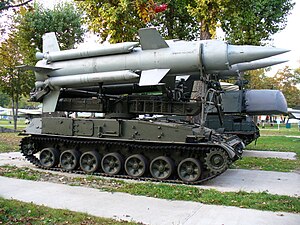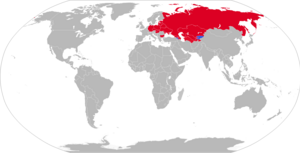This article has multiple issues. Please help improve it or discuss these issues on the talk page. (Learn how and when to remove these messages)
|
| 2K11 Krug NATO reporting name: SA-4 "Ganef" | |
|---|---|
 2K11 TEL carrying two 3M8 missiles at Saint-Petersburg Artillery museum 2K11 TEL carrying two 3M8 missiles at Saint-Petersburg Artillery museum | |
| Type | Transportable SAM system |
| Place of origin | Soviet Union |
| Service history | |
| In service | 1965-present 1965-1990s (USSR) |
| Used by | See list of operators |
| Production history | |
| Designer | Lyulev Novator |
| Designed | 1957 |
| Manufacturer | MZiK |
| Variants | Krug, Krug-A, Krug-M, Krug-M1, Krug-M2, Krug-M3 |
| Specifications (2K11 Krug) | |
| Mass | 28,200 kg (62,200 lb) |
| Length | 7.5 m (25 ft) (9.46 m (31 ft) with missiles) |
| Width | 3.2 m (10 ft) |
| Height | 4.472 m (14 ft 8 in) (with missiles) |
| Crew | 3 to 5 |
| Armour | 15 mm (0.59 in) |
| Engine | V59 V-12 water-cooled diesel 520 hp |
| Power/weight | 17.33 hp/t |
| Ground clearance | 0.44 m (1 ft 5 in) |
| Fuel capacity | 850 L (190 imp gal; 220 US gal) |
| Operational range | 780 km (480 mi) |
| Maximum speed | 35 km/h (22 mph) |
The 2K11 Krug (Russian: 2К11 Круг; English: 'circle') is a Soviet and now Russian medium-range, medium-to-high altitude surface-to-air missile (SAM) system. The system was designed by NPO Novator and produced by Kalinin Machine Building Plant. Its GRAU designation is "2K11." Its NATO reporting name is SA-4 Ganef, after the Yiddish (originally Hebrew) word גנבֿ meaning 'thief'; the name was used because the system resembled the Bristol Bloodhound.
Development and service
Development of the Krug ZRK-SD (2K11) air defense system started in 1957 by the Lyulev OKB design bureau. It was first displayed during a parade in Moscow in May 1965. The system started to be fielded in 1967 and became fully operational in 1969. It was used by the Soviet Army as a long-range SAM.
The early version of the Krug entered service in 1965. The first operational deployment version, the Krug-A, entered service in 1967, with extensively modified versions, the Krug-M in 1971 and the Krug-M1 in 1974, which were developed to rectify problems discovered during army service. A target drone called 9M316M Virazh, developed from obsolete Krug missiles, was proposed for export in 1994.
The 2K11 was briefly operated by the Soviet army during the war in Afghanistan in 1979 and 1980, but was withdrawn several months after the initial invasion. In 1997, it was reported that, between 1993 and 1996, some 27 fire units of Krug and 349 missiles had been sold to Armenia. Poland flight tested four missiles in September 2006 against P-15 Termit (SS-N-2 'Styx') targets.

Description
Vehicles

The TEL vehicles are tracked based on a GM-123 chassis and carry two missiles each on an elevating turntable for up to 360-degree rotation and 70-degree elevation. The two primary versions of the missile in service are the 9M8M1 (former designation 3M8M1) (2K11M "Krug-M") and 9M8M2 (former designation 3M8M2) (2K11M2/3 "Krug-M1"), both of which are believed to be known to the US DoD as SA-4B. The original 9M8 (former designation 3M8) (SA-4A) was first introduced into service in 1965 and followed by the upgraded 9M8M (2K11A "Krug-A") in 1967 before the 9M8M1 in 1971 and the 9M8M2 in 1973. The 9M8M2 actually has a lower maximum engagement altitude and shorter range in exchange for better performance in engaging aircraft close to the battery. Each battery typically consists of two 9M8M1 missiles and four 9M8M2 missiles as well as the following radars:
- P-40 "Long Track" (1S12) E-band early warning radar (also used by the 2K12 Kub and 9K33 Osa, range 175 km/108 miles) (modified AT-Ts), in divisions command post
- 1S32 "Pat Hand" H-band continuous wave fire control and guidance radar (range 128 km/80 miles)
- PRV-9 "Thin Skin" E-band height finding radar (also used by the 2K12 Kub and 9K33 Osa, range 240 km/148 miles), in regiments or brigades command post
Only "Long Track" is mounted on a modified AT-T vehicle, TEL 2P24 and "Pat Hand" 1S32 are mounted on GM-123/ GM-124. "Thin Skin" is mounted on a truck. Batteries may also feature Ural 375D trucks 2T6 carrying spare missiles for reloading the launchers.
Missile
Surface-to-air missile| 9M8 | |
|---|---|
 TEL at Ukrainian Air Force Museum in Vinnitsa. TEL at Ukrainian Air Force Museum in Vinnitsa. | |
| Type | Surface-to-air missile |
| Place of origin | Soviet Union |
| Production history | |
| Variants | 3M8 (later 9M8) Krug, 9M8M Krug-M, 9M8M1 Krug-M1, 9M8M2 Krug-M2, 9M8M3 Krug-M3. |
| Specifications (9M331) | |
| Mass | 2,453 kg (5,408 lb) |
| Length | 8,784 mm (28 ft 10 in) |
| Diameter | 860 mm (2 ft 10 in) |
| Warhead | Frag-HE |
| Warhead weight | 150 kg (330 lb) |
| Detonation mechanism | contact and proximity fuzes |
| Propellant | kerosene fuelled ramjet |
| Operational range | 55 kilometres (34 mi) |
| Flight altitude | 24,500 metres (80,400 ft) |
| Boost time | four solid fuel booster rocket motors |
| Maximum speed | Mach 4 |
| Guidance system | Radio command |
The missiles are launched with the aid of four solid rocket fuel rocket motors inside boosters attached to the outside of the missile. Once they have burned and the missile is aloft, a liquid-fuelled ramjet sustainer engine is ignited. It reaches speeds of up to Mach 4 and has an effective range of 50–55 km (31–34 miles) depending upon the version. It carries a 135 kg (300 lb) fragmentation warhead. Possible engagement altitudes range from 100 m to 27 km (330-88,500 feet). The 3M8 missile was designed and produced by NPO Novator.
Optical tracking is possible for guidance in a heavy ECM environment.
Survivability and anti-jamming capabilities
The Krug had several features that improved the survivability of the radar against anti-radiation missiles. In PI mode (ПИ) the system only briefly illuminated the target and the computer calculated its prolonged path based on data received from early warning radars. After a longer passive period the main radar illuminated the calculated flight direction of the target for a few seconds and recalculate path of the target if necessary (if the distance between the calculated track and the actual position is greater than 7 km). As a result, the system emitted detectable signals only for a few seconds every few minutes, making it difficult to jam or launch an anti-radar missile against the Krug. The system was also able to track the target in full-passive automated PNS (ПHC) mode based on the data provided by "Long Track" mobile EWR via radio datalink. In this mode it was almost impossible to detect the Krug system until the moment of a missile launch, because the Krug did not emit radiation at all.
In 3M mode (3m aka three-point) the Krug could home on a jamming target (e.g., AN/ALQ-99). Jamming signals were supposed to protect the aircraft made it into a target in this mode.
Structure of Krug missile system
SAM-regiment have two SAM-battalions, SAM-brigade have three SAM-battalions. In each headquarter, brigade, regiment and battalion, is one command battery. In each SAM-battalion have three SAM-batteries.
- Self-propelled launch vehicle 2P24 on GM-123 base, three in each SAM- battery
- Rocket guidance station 1S32 on GM-124 base, one in each SAM- battery
- Target detection station 1S12 on modified AT-T base, one in each command battery
- Transporter-loader vehicle 2T6 on Ural truck base, one in each SAM- battery
Variants
- 2K11A Krug A
- 2K11M
- 2K11M1
- M-31 Krug M – naval
Operators

Current operators
 Armenia - Still in use as of February 2023.
Armenia - Still in use as of February 2023. Turkmenistan – 2 batteries as of February 2023.
Turkmenistan – 2 batteries as of February 2023.
Former operators

 Azerbaijan - Operated at least until 2021.
Azerbaijan - Operated at least until 2021. Bulgaria – 30, in reserve
Bulgaria – 30, in reserve Czechoslovakia - Phased out in early 1990s.
Czechoslovakia - Phased out in early 1990s. East Germany - Passed onto successor state.
East Germany - Passed onto successor state. Germany – Phased out during the 1990s
Germany – Phased out during the 1990s Georgia – Operated at least until 2008.
Georgia – Operated at least until 2008. Hungary - 18 batteries in 1991. Phased out in middle 1990s.
Hungary - 18 batteries in 1991. Phased out in middle 1990s. Kazakhstan - Operated at least until 2021.
Kazakhstan - Operated at least until 2021. Kyrgyzstan - Operated at least until 2021.
Kyrgyzstan - Operated at least until 2021. Poland – 30. Phased out in 2011.
Poland – 30. Phased out in 2011. Russia – 500 launchers (2007) (phased out in 1990s) Missiles used as targets for training(Virazh/-M 9M316M)
Russia – 500 launchers (2007) (phased out in 1990s) Missiles used as targets for training(Virazh/-M 9M316M) Soviet Union - Passed on to successor states.
Soviet Union - Passed on to successor states. Ukraine - 100 launchers in 2014. Phased out.
Ukraine - 100 launchers in 2014. Phased out.
Notes
- ^ "Almaz/Antei Concern of Air Defence – 2K11 Krug (SA-4 'Ganef') medium to high-altitude surface-to-air missile system". Jane's Information Group. 2008-07-02. Archived from the original on 2012-02-10. Retrieved 2008-08-18.
- "rocket and missile system | weapons system | Britannica". www.britannica.com.
- ^ "Krug (SA-4 'Ganef')". Jane's Information Group. 2008-02-13. Retrieved 2008-08-18.
- Boris Dukhov, Anatoly Shiroky, Building combat skills Archived 2011-07-17 at the Wayback Machine, Military Parade
- Urban, Mark. War in Afghanistan, 43, 66.
- Szabó, Miklós (2011). "A Krug légvédelmi rakétarendszer" (PDF). Haditechnika. 5: 33.
- ^ International Institute for Strategic Studies (15 February 2023). The Military Balance 2023 (1st ed.). Routledge. ISBN 978-1032508955.
- ^ International Institute for Strategic Studies (25 February 2021). The Military Balance 2021 (1st ed.). Routledge. ISBN 978-1032012278.
- ^ International Institute for Strategic Studies (1991). The military balance. 1991-1992. London: Brassey's. ISBN 978-0080413259.
- ^ Institute for Strategic Studies (1989). The military balance, 1989-1990. London: Brassey's. ISBN 978-0080375694.
- International Institute for Strategic Studies (5 February 2008). The Military Balance. 2008. Routledge. ISBN 978-1857434613.
- "Missiles 2". Archived from the original on 2012-12-23. Retrieved 2012-08-13.
- "Люльев Лев Вениаминович | MilitaryRussia.Ru — отечественная военная техника (после 1945г.)".
- International Institute for Strategic Studies (5 February 2014). The Military Balance 2014 (1st ed.). Routledge. ISBN 978-1032508955.
External links
- SA-4 Ganef at Global Security website
- SA-4 Ganef Archived 2016-08-28 at the Wayback Machine at Federation of American Scientists website
- Photos of Polish Krug at Vestnik PVO website
- 2K11 KRUG-M1 (SA-4B Ganef) Simulator